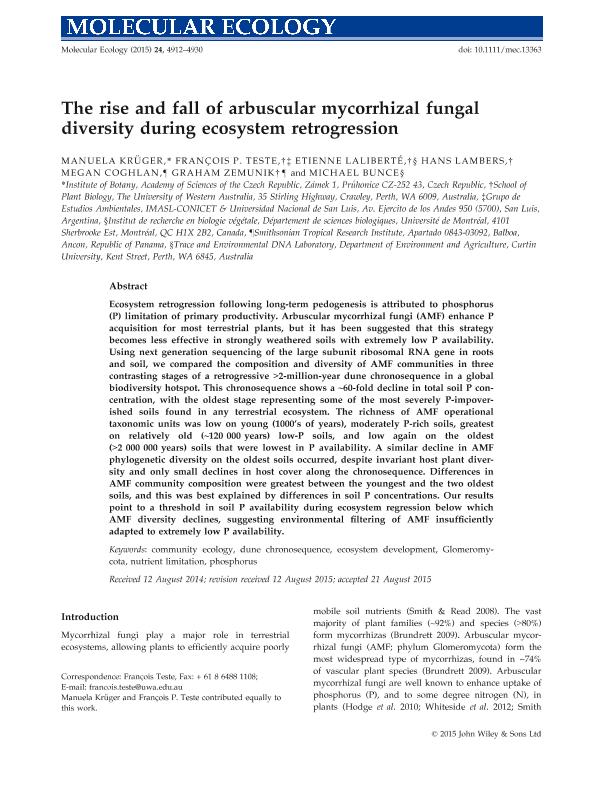Artículo
The rise and fall of arbuscular mycorrhizal fungal diversity during ecosystem retrogression
Kruger, Manuela; Teste, Francois ; Laliberté, Etienne; Lambers, Hans; Coghlan, Megan; Zemunik, Graham; Bunce, Michael
; Laliberté, Etienne; Lambers, Hans; Coghlan, Megan; Zemunik, Graham; Bunce, Michael
 ; Laliberté, Etienne; Lambers, Hans; Coghlan, Megan; Zemunik, Graham; Bunce, Michael
; Laliberté, Etienne; Lambers, Hans; Coghlan, Megan; Zemunik, Graham; Bunce, Michael
Fecha de publicación:
06/2015
Editorial:
Wiley
Revista:
Molecular Ecology
ISSN:
0962-1083
Idioma:
Inglés
Tipo de recurso:
Artículo publicado
Clasificación temática:
Resumen
(P) limitation of primary productivity. Arbuscular mycorrhizal fungi (AMF) enhance P acquisition for most terrestrial plants, but it has been suggested that this strategy becomes less effective in strongly weathered soils with extremely low P availability. Using next generation sequencing of the large subunit ribosomal RNA gene in roots and soil, we compared the composition and diversity of AMF communities in three contrasting stages of a retrogressive >2-million-year dune chronosequence in a global biodiversity hotspot. This chronosequence shows a ~60-fold decline in total soil P concentration,with the oldest stage representing some of the most severely P-impoverishedsoils found in any terrestrial ecosystem. The richness of AMF operationaltaxonomic units was low on young (1000?s of years), moderately P-rich soils, greatest on relatively old (~120 000 years) low-P soils, and low again on the oldest (>2 000 000 years) soils that were lowest in P availability. A similar decline in AMF phylogenetic diversity on the oldest soils occurred, despite invariant host plant diversity and only small declines in host cover along the chronosequence. Differences in AMF community composition were greatest between the youngest and the two oldest soils, and this was best explained by differences in soil P concentrations. Our results point to a threshold in soil P availability during ecosystem regression below which AMF diversity declines, suggesting environmental filtering of AMF insufficiently adapted to extremely low P availability.
Archivos asociados
Licencia
Identificadores
Colecciones
Articulos(IMASL)
Articulos de INST. DE MATEMATICA APLICADA DE SAN LUIS
Articulos de INST. DE MATEMATICA APLICADA DE SAN LUIS
Citación
Kruger, Manuela; Teste, Francois; Laliberté, Etienne; Lambers, Hans; Coghlan, Megan; et al.; The rise and fall of arbuscular mycorrhizal fungal diversity during ecosystem retrogression; Wiley; Molecular Ecology; 24; 19; 6-2015; 4912-4930
Compartir
Altmétricas



